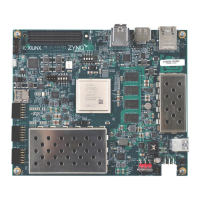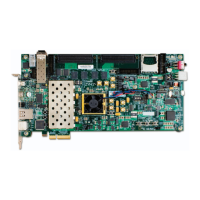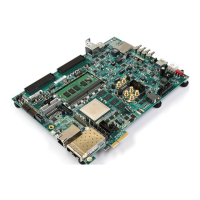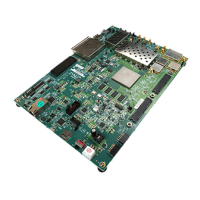Zynq-7000 PCB Design Guide www.xilinx.com 45
UG933 (v1.8) November 7, 2014
Chapter 4: SelectIO Signaling
The SSTL standards tend to not have rigid requirements for termination topology. Rather, the JEDEC
specifications provide example termination techniques that tend to be the commonly used
topographies. The “SelectIO Resources” chapter of UG471
, 7 Series FPGAs SelectIO Resources User
Guide provides example termination techniques for each of the I/O standards, including the SSTL
standards, for the purpose of providing a good starting point for consideration. Similar to HSTL, it is
ultimately up to the designer to verify through simulation and measurement that the signal integrity
at the receiver is adequate.
Unidirectional Multi-Drop Topographies
In more complex topographies, a single driver can drive multiple receivers. The receivers
represent loads that must be fed by individual transmission line stubs. From a signal
integrity standpoint, the best topography to use in this case is a single long transmission
line with the driver at one end and parallel termination at the other, with receivers
connected to the main trace by short stubs in between. This type of topography is often
referred to as a flyby multi-drop topography.
There are two critical aspects of this topography. The first is the presence of a single parallel
termination at the far end of the transmission line. Series termination at the driver or a
controlled impedance driver must never be used. Parallel termination is the only applicable
termination type for this topography. The second critical aspect is the length of the
connecting stubs at each receiver. These must remain short: no more than a fraction of a
signal rise time in length. With a typical signal rise time of 600 ps, a stub no longer than
700 ps/4 = 150 ps, or 0.9 inches (22.86 mm) should be used. As the stubs become longer,
they present a larger impedance discontinuity to the signal travelling down the
transmission line, and can support significant reflections. These impedance discontinuities
corrupt the signal. With increasing numbers of loads and increasing length of stubs, the
signal is corrupted to the point where it is no longer usable.
Star topographies are not recommended. The constraints involved in designing a star
topography with good signal integrity are beyond the scope of this document.
As stated in Unidirectional Point-to-Point Topographies, ideal parallel resistive termination
has a value equal to the characteristic impedance of the transmission line it is terminating.
The best performance is achieved when V
TT
is equal to half of the signaling voltage, and
when this voltage is not available, a Thevenin parallel termination is recommended, as
defined in the previous section.
Figure 4-6 illustrates a Thevenin parallel termination powered from V
CCO
, made up of two
100Ω resistors, resulting in a V
TT
of V
CCO
/2 and a parallel equivalent resistance of 50Ω . This
figure shows a topography with one driver (an LVCMOS driver) and four receivers. The
driver is on the left side, the receivers are spaced at interim points across the 50Ω
transmission line, and the Thevenin parallel termination of two 100Ω resistors is on the
right side.

